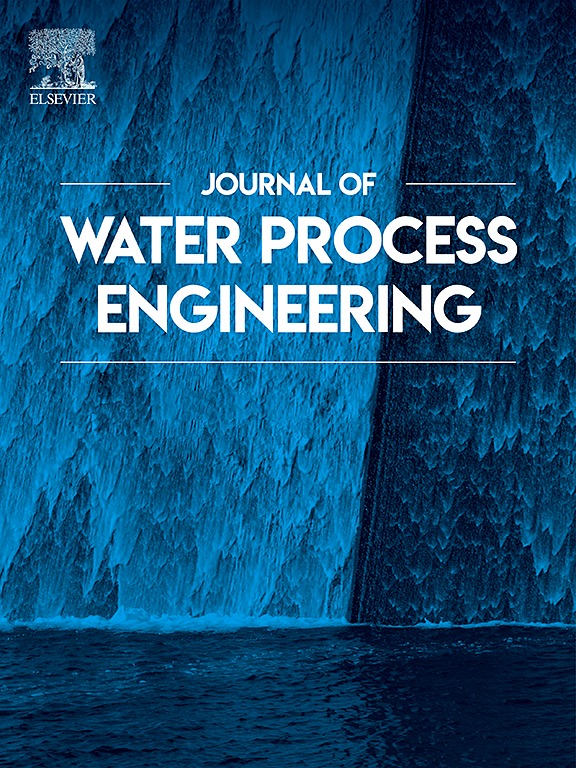Inhibition of metformin on sewage sludge anaerobic digestion: Focusing on changes in microbial metabolites and community/functional genes
IF 6.3
2区 工程技术
Q1 ENGINEERING, CHEMICAL
引用次数: 0
Abstract
Metformin (MEF) is commonly used in the treatment of diabetes and is often detected in sewage sludge, but its effect on anaerobic digestion (AD) for methane (CH4) production has rarely been investigated. This study revealed the influence of MEF on AD of sewage sludge. MEF significantly interfered with AD process, causing CH4 yield reduction of 9.67 % and 30.18 % exposure on 6 mM and 9 mM of MEF, compared to the control groups without MEF, respectively. Liquid phase analyses revealed that MEF led to the accumulation of butyric and acetic acids and the increase in protein and polysaccharide contents at the initial stage of AD, showing the sludge dissolution. In addition, the high-throughput sequencing identified Firmicutes as the main contributor to the accumulation of volatile fatty acids (VFAs), with its relative abundance rising from 35.45 % to 47.48 %. Conversely, the relative abundance of Methanosaeta decreased from 56.21 % to 36.0 %, causing low CH4 yield. Furthermore, an analysis of the changes in enzyme abundance involved in metabolic processes indicated that MEF could disrupt the metabolic pathway, thereby inhibiting CH4 yield. Surprisingly, MEF could not be decomposed by anaerobes while it could be adsorbed by the sludge in AD. Thus, low cost and efficient pretreatment techniques for the PPCPs containing sewage waste are recommended to obtain suitable substrates for more CH4.

二甲双胍对污水污泥厌氧消化的抑制作用:关注微生物代谢物和群落/功能基因的变化
二甲双胍(MEF)通常用于治疗糖尿病,并且经常在污水污泥中检测到,但其对厌氧消化(AD)产生甲烷(CH4)的影响很少被研究。本研究揭示了MEF对污泥AD的影响。MEF显著干扰AD过程,与未处理MEF的对照组相比,MEF处理6 mM和9 mM的CH4产量分别降低9.67%和30.18%。液相分析表明,在AD初期,MEF导致丁酸和乙酸积累,蛋白质和多糖含量增加,表现为污泥溶解。此外,高通量测序发现厚壁菌门是挥发性脂肪酸(VFAs)积累的主要贡献者,其相对丰度从35.45%上升到47.48%。相反,甲烷藻的相对丰度从56.21%下降到36.0%,导致CH4产率降低。此外,对代谢过程中酶丰度变化的分析表明,MEF可以破坏代谢途径,从而抑制CH4的产量。令人惊讶的是,MEF不能被厌氧菌分解,而可以被AD中的污泥吸附。因此,建议采用低成本和高效的预处理技术来处理含污水的PPCPs,以获得合适的底物来处理更多的CH4。
本文章由计算机程序翻译,如有差异,请以英文原文为准。
求助全文
约1分钟内获得全文
求助全文
来源期刊

Journal of water process engineering
Biochemistry, Genetics and Molecular Biology-Biotechnology
CiteScore
10.70
自引率
8.60%
发文量
846
审稿时长
24 days
期刊介绍:
The Journal of Water Process Engineering aims to publish refereed, high-quality research papers with significant novelty and impact in all areas of the engineering of water and wastewater processing . Papers on advanced and novel treatment processes and technologies are particularly welcome. The Journal considers papers in areas such as nanotechnology and biotechnology applications in water, novel oxidation and separation processes, membrane processes (except those for desalination) , catalytic processes for the removal of water contaminants, sustainable processes, water reuse and recycling, water use and wastewater minimization, integrated/hybrid technology, process modeling of water treatment and novel treatment processes. Submissions on the subject of adsorbents, including standard measurements of adsorption kinetics and equilibrium will only be considered if there is a genuine case for novelty and contribution, for example highly novel, sustainable adsorbents and their use: papers on activated carbon-type materials derived from natural matter, or surfactant-modified clays and related minerals, would not fulfil this criterion. The Journal particularly welcomes contributions involving environmentally, economically and socially sustainable technology for water treatment, including those which are energy-efficient, with minimal or no chemical consumption, and capable of water recycling and reuse that minimizes the direct disposal of wastewater to the aquatic environment. Papers that describe novel ideas for solving issues related to water quality and availability are also welcome, as are those that show the transfer of techniques from other disciplines. The Journal will consider papers dealing with processes for various water matrices including drinking water (except desalination), domestic, urban and industrial wastewaters, in addition to their residues. It is expected that the journal will be of particular relevance to chemical and process engineers working in the field. The Journal welcomes Full Text papers, Short Communications, State-of-the-Art Reviews and Letters to Editors and Case Studies
 求助内容:
求助内容: 应助结果提醒方式:
应助结果提醒方式:


